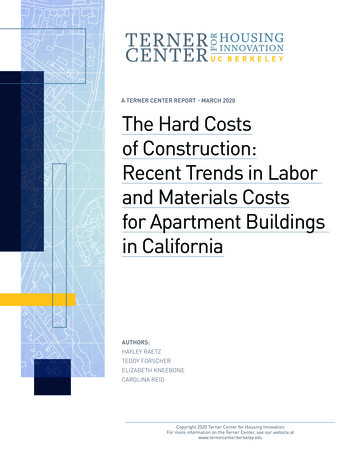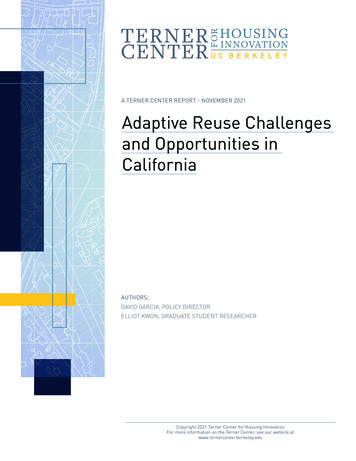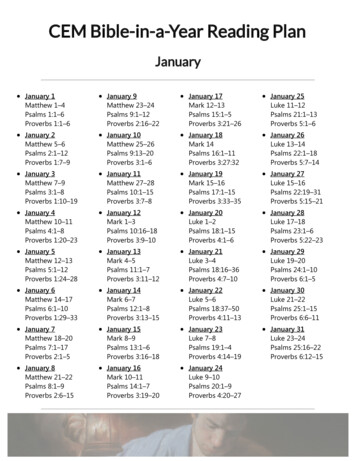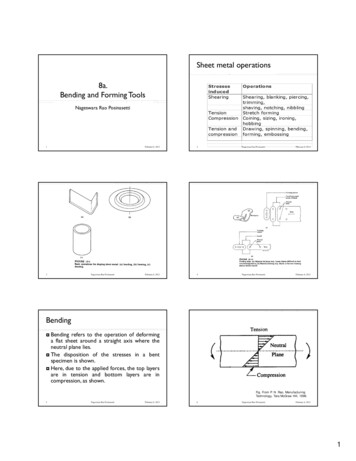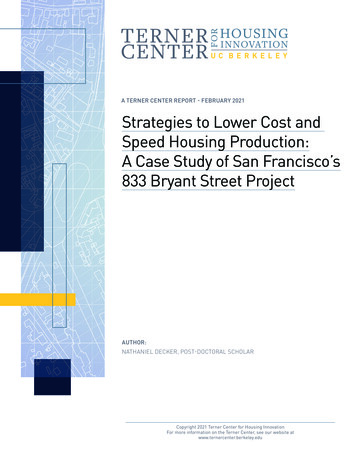
Transcription
A TERNER CENTER REPORT - FEBRUARY 2021Strategies to Lower Cost andSpeed Housing Production:A Case Study of San Francisco’s833 Bryant Street ProjectAUTHOR:NATHANIEL DECKER, POST-DOCTORAL SCHOLARCopyright 2021 Terner Center for Housing InnovationFor more information on the Terner Center, see our website atwww.ternercenter.berkeley.edu
A TERNER CENTER REPORT - FEBRUARY 2021Executive SummaryAcross the United States, the high costsof developing subsidized housing hindersefforts to address the affordability crisisof low- and moderate-income familiesand provide homes for unhoused individuals. The number of people paying half ormore of their income for housing remainsat historically high levels, and after manyyears of decline, homelessness has beenon the rise, particularly in California.Levels of public subsidy for housing havenot kept pace with these growing needs.At the same time, higher costs per unit tobuild affordable housing mean that statesand localities produce fewer units withthe same amount of subsidy, even as morepeople are in need of these units.While these problems exist across theU.S., San Francisco is exceptional both interms of the need for affordable housingand the high cost to provide those homes.Not only has homelessness in San Francisco worsened in the past five years, butthe COVID-19 pandemic has put evenmore stress on extremely low-incomerenters and placed many at greater risk ofbecoming unhoused.Permanent supportive housing (PSH),where residents are provided with anapartment in conjunction with a rangeof services, is a proven method to reducehomelessness and has even been shownto require less public expenditure thanleaving people unhoused. The city of SanFrancisco has committed to building morePSH but is not currently building at thepace required to meet the need.A number of factors pose barriers tobuilding more PSH housing in the city.Development timelines for affordableprojects in San Francisco have typicallystretched to 6 years or longer and development costs have reached 600,000 to 700,000 per unit. This is a far slower andmore costly process than other dense citiesin high-cost areas, even other high-costareas in California. While there is widespread agreement in the public and privatesectors that the length of developmenttimelines and high price of constructionare problems, they have yet to be addressedin a comprehensive way.These challenges have been a focal pointfor the Chronic Homelessness Initiativelaunched by Tipping Point Community—aphilanthropic organization in the Bay Area.The goal of the Initiative is to reduce chronichomelessness by 50 percent between 2017and 2022. To help meet that goal, TippingPoint partnered with the San FranciscoHousing Accelerator Fund (HAF) to: (i)develop a new model for building qualityPSH at lower cost, and (ii) establish arevolving fund to support multiple projects and leverage additional funding. Theyfirst set out to build new housing in underthree years and at a cost of 400,000 orless per unit. Tipping Point Communitycontracted with the HAF to create andstructure the Homes for the HomelessFund and lead project investment andimplementation efforts. The Homes for theHomeless Fund’s first project, a permanentsupportive housing development currentlyunder construction at 833 Bryant Street,is on target to meet those goals, which aresubstantially below the cost and timelinesthat are typical for San Francisco projects. The Bryant Street project is fundedin part by the Initiative through the SanFrancisco Housing Accelerator Fund withMercy Housing acting as the developer. Itis expected to be completed in July 2021.2
A TERNER CENTER REPORT - FEBRUARY 2021This brief assesses 833 Bryant’s development process to date, with a specific focuson: (i) understanding how timelines andcosts for 833 Bryant compare to San Francisco norms, (ii) how the project achievedprojected time and cost savings, and (iii)what lessons can be taken from this projectfor both the public and private sectors. Toinform this analysis, we interviewed therelevant stakeholders involved with theproject, and we analyzed the financials of833 Bryant, a number of comparison projects, and data on affordable housing development costs in the area more generally.The results of our analysis find that 833Bryant is on target to be completed 33months after land acquisition, and we estimate that the development cost is set tocome in at 382,917 per unit. To put that inperspective, 833 Bryant is on pace to buildhomes, conservatively, about 30 percentfaster and at 25 percent less cost per unitthe similar project.We determined that the project was ableto achieve these time and cost savingsthrough a package of four cost efficiencies:1. Committing to defined and ambitious cost and timeline goals.Tipping Point Community established defined and ambitious cost andtimeline goals up front, which led thedevelopment team to innovate in thefinancing and design of the project.2. Deploying unrestricted capitalto fund many costs duringconstruction.833 Bryant benefited from a large poolof flexible funding unrestricted by theregulations that typically come withsubsidies. This capital came from theHomes for the Homeless Fund established by Tipping Point and HAF. Incontrast to most funding for affordablehousing, which requires detailed paperwork, or specified returns, these fundshad no terms other than to support thedevelopment of PSH deals done quicklyand at relatively low cost. Furthermore, while it was understood that,ideally, these funds would be revolvedto support additional developments,HAF and Tipping Point were willing toaccept the risk that the funds would notbe returned from the project.3. Receiving approval for theStreamlined MinisterialApproval Process under SenateBill 35.This law allowed 833 Bryant to movethrough the permitting process muchfaster and with less risk.4. Using off-site construction ofapartment units.Off-site construction of apartmentunits atFactory OS allowed theproject to simultaneously build unitsand engage in site work, shortening thedevelopment timeline.The savings achieved by this package ofefficiencies are greater than the sum of itsparts and taken together resulted in a farmore flexible and streamlined developmentprocess. The timeline savings of the projectare particularly important. Subsidizedhousing often follows a more convoluteddevelopment process than unsubsidizedhousing and by streamlining the process,833 Bryant was able to avoid many ofthese direct costs. Faster timelines alsomeant locking in lower construction costs.Between 2008 and 2018, multifamilyconstruction costs in the region rose byover 8 percent annually. Timeline savingsare especially important for PSH, as slowerdevelopment means unhoused individuals3
A TERNER CENTER REPORT - FEBRUARY 2021remain homeless longer. 833 Bryant’squick timeline means that 145 homelesspeople will be housed months or evenyears sooner than if the project had beendeveloped through the typical processes.And there are lessons to be learned thatextend beyond PSH projects. 833 Bryant’sgoals of cost and time efficiency led thedevelopment team to a new way to produceaffordable units, faster, and for less subsidy.Their focus on cost and time efficiencies isapplicable nationwide, as the scarcity ofaffordable housing coupled with limitedsubsidy dollars is a major issue across thecountry.IntroductionThe cost to develop affordable units hasa major impact on how many low-income people, including those currentlyunhoused, can be stably housed. Affordability, especially for low-income renters isat crisis levels. After many years of declines,homelessness has been on the rise in theU.S., particularly in California. Levels ofpublic subsidy for housing have not keptpace with this rising need. Higher costsper unit to build affordable housing meanthat states and localities produce fewerunits with the same amount of subsidy,even as more people are in need of theseunits. While these problems exist acrossthe U.S., San Francisco is exceptional bothin terms of the need for affordable homesand the high cost to build them. Evenwith new local subsidies coming online tosupport affordable housing construction inthe city, the number of new units requiredfar outstrips available resources.in the region by half in five years. A keycomponent of that initiative is to pilotnew ways to develop quality permanentlysupportive units in San Francisco in underthree years and at a cost of 400,000 orless per unit—significantly faster andcheaper than is typical for such projects inthe city. The first development to receivefunds through the program is currentlyunder construction at 833 Bryant Streetand is scheduled to be completed in July2021.This analysis evaluates the progress of theBryant Street project to date, comparingit to affordable development norms inthe city and to specific newly constructedPSH projects. The remainder of the reportprovides context for the project’s development, an overview of methods used toassess its development timeline and financials and identifies key elements that havecontributed to Bryant Street’s projectedtime and cost efficiencies. The reportconcludes with recommendations for waysin which other projects—in San Franciscoand beyond—can produce housing relatively quickly and at lower cost, and howthe public sector can change laws and policies to facilitate the quick, efficient development of desperately needed homes forunhoused individuals.Tipping Point Community—a Bay Areaphilanthropic organization—launched itsChronic Homelessness Initiative in 2017with the goal of reducing homelessness4
A TERNER CENTER REPORT - FEBRUARY 2021BackgroundSan Francisco’s HomelessnessCrisis and the Need for PermanentSupportive HousingCost efficiency in the production of subsidized housing is essential in the face ofthe high levels of need and limited subsidyfunds. The number of people facing direhousing needs in the U.S. has been athistorically high levels for the past decade.1Levels of subsidy, particularly from thefederal government, have not kept pacewith rising need, leaving a larger portionof extremely low-income families withoutaccess to the housing assistance for whichthey are eligible.2 After many years ofdeclines, levels of homelessness in the U.S.began to rise in 2015, driven in part bygrowing affordability challenges.3California faces especially high affordability pressures and has seen especiallysharp increases in the costs of developingsubsidized housing. Construction costs perunit for Low-Income Housing Tax Credit(LIHTC) developments rose 11 percentin real terms from 2011 to 2015 in California, even as costs held flat in other partsof the country.4 Increases in the homelesspopulation in the state have also outpacednational trends since 2011, and the numberof people experiencing homelessness inSan Francisco has risen even faster thanthe state level, growing more than 40percent from 2011 to 2019 (Figure 1). Inaddition, the population of people experiencing chronic homelessness, definedby HUD as people who have experiencedhomelessness for a year or longer and alsohave a disabling condition that preventsthem from securing work or housing, hasrisen from 1,977 in 2011 to 3,030 in 2019(Figure 1).5 Note that these numbers donot reflect the impacts of the COVID-19pandemic over the past year, which ispoised to deepen the homelessness crisis.6Figure 1: Homelessness in San 14Total People Experiencing Homelessness20152016201720182019People Experiencing Chronic Homelessness5
A TERNER CENTER REPORT - FEBRUARY 2021Permanent supportive housing (PSH) is aproven solution to homelessness, particularly for people experiencing chronichomelessness, a population with ratesof substance abuse and physical andmental disability that are higher than theunhoused population in general. Substantial evidence shows that so-called “housingfirst” strategies, where unhoused peopleare first provided with a home and thenoffered a range of supportive services,lead to long-term stability for the chronically homeless and can even result inless public-sector expenses than leavingpeople unhoused.7 The city has identifiedthe production of PSH as a priority andhas generated 550 units since 2016, withhundreds more in the pipeline.8 However,the challenges are currently outpacing thesolution. One reason for this is the exceptionally slow development timeline to buildunits, coupled with the exceptionally highcost to build new housing, particularlyaffordable and supportive housing, in SanFrancisco.9Piloting a New Approach toPermanent Supportive HousingDevelopment: 833 Bryant StreetAs part of its Chronic HomelessnessInitiative, Tipping Point was interested ineffective ways to increase and acceleratethe production of new supportive housing.Tipping Point partnered with the SanFrancisco Housing Accelerator Fund(HAF) to develop a concept to increasethe speed of construction and decreasethe cost to build by pairing flexibleprivate funds with long-term sustainablegovernment funding. After developing aprogram model together, Tipping Pointprovided 50 million to the HAF to createthe Homes for the Homeless Fund with theexplicit goal of developing PSH faster and atlower cost than similar projects. The Funditself provides a structure that is meantto encourage speed and cost efficiency. Itsmission is to provide affordable housing,but as a public-private partnership it hasmore flexibility and can operate morenimbly than public agencies. This was aparticular advantage for 833 Bryant, asHAF was able to move quickly to acquire apromising site that was privately held, thusavoiding the often-lengthy processes thataccompany the development of publiclyheld sites. While the Fund has acted as alender to a number of projects across thecity, this is the first deal that uses the capitalprovided by Tipping Point Community andwhere HAF has taken a more active role indevelopment.The site at 833 Bryant had originally beenused as surface parking and was zonedas Service/Arts/Light Industrial. Priorto acquisition, HAF assembled the development team and worked with the Cityon a zoning amendment that allowed theconstruction of affordable housing onsites like 833 Bryant. The site was entitled in six months for the construction of145 units permanent supportive housingreserved for people who have experiencedchronic homelessness, plus one unit for themanager.HAF purchased the site in October2018 using unrestricted capital that wasprovided by Tipping Point and was notsubject to the same requirements orexpectations typically attached to privateor public subsidy sources. HAF also usedthese funds to provide a low-cost loan forpredevelopment and initial constructionexpenses (including a substantial portionof the off-site construction). These fundswere partially returned to HAF with thedeployment of a 33,282,714 mortgage,funded with tax-exempt private activity6
A TERNER CENTER REPORT - FEBRUARY 2021bonds. The HAF construction funds willbe fully returned with the deployment of 21,673,000 in associated LIHTC equity.10Further public subsidies come in the formof an operating lease from the city of 1.4million per year and a master lease fromthe city of 1.9 million per year, withpayments beginning in 2022. Additionally,HAF is providing subsidy directly to thedeal by providing the site to the city aftera 30-year ground lease, and by providingdevelopment services without compensation, thus allowing for a lower collecteddeveloper fee than is standard.Tipping Point and HAF partnered tolaunch the first project, jointly interviewingand choosing an architect, developer,contractor, and modular company. MercyHousing was chosen to act as developer onthe project. The units are all small studiosof about 260 square feet each, which isappropriate given that the vast majority(94 percent) of people experiencing chronichomelessness in San Francisco are singleadults without children.11 The units wereconstructed off-site by Factory OS.MethodsResearch for this project consisted of interviews with members of the 833 Bryantdevelopment team, analysis of the project’sfinancials and development process, andcomparisons with aggregated developmentcost data and the financials of four specificdevelopments. The teams at both HAFand Mercy have many years of experiencedeveloping housing in San Francisco andwere able to describe in detail how thedevelopment of 833 Bryant differed fromother, similar developments.Establishing whether the project achievedits cost and development timeline reduction goals is not a straightforward questionbecause, in a number of important ways,833 Bryant is an atypical project. At somelevel of detail, every development is unique.The development process in San Franciscois unlike the process in even adjacent citieslike Oakland. The specifics of developmentsites also vary, the costs of labor and materials change, and the methods of financingprojects are rarely the same from projectto project. There have been many multifamily affordable housing projects in thecity of San Francisco in the past few years,though non-supportive housing projectsrarely have all or nearly all of their units asstudios. Permanent supportive housing isoften 100 percent studios, but 833 Bryant’sunits are notably smaller than typical PSHin the city.12For this reason, we use a few referencepoints to measure the project’s cost savingsand reductions in development timeline. The first reference point is averagedcosts for subsidized multifamily housingconstruction in San Francisco. Data onconstruction costs are very limited, andthis portion of the analysis relies on dataon development costs by the Terner Center(from application materials for 9 percentLIHTC projects) in California and datafrom the San Francisco Mayor’s Office ofHousing and Community Development(MOHCD) on multifamily projects theyhave recently funded. To account for thefact that 833 Bryant is 100 percent smallstudio units we use cost averages in termsof costs per residential square foot andgross square foot, in addition to cost perunit. Unlike Single Room Occupancy projects (SROs), 833 Bryant is composed offull units, with a bathroom and kitchen.Costs per unit for microunit projects looklow because more units are arranged intothe floor area of the project, whereas costsper residential square foot appear highbecause more expensive facilities like7
A TERNER CENTER REPORT - FEBRUARY 2021kitchens and bathrooms are also arrangedinto the residential area of the project. Itis unclear whether to expect costs pergross square foot of 833 Bryant to be highor low because—though the residentialareas will cost more—833 Bryant is a veryefficient building, with little space necessary for circulation and relatively littlespace programmed for non-apartmentuses. Non-apartment uses are common inaffordable development in San Francisco.We also compare 833 Bryant to fourspecific projects: 1064 Mission, MissionBay Block 9, Casa de la Misión, and ParcelO. The first three are new construction, 100percent small studio apartment, permanent supportive housing projects in SanFrancisco, all of which are currently underconstruction. These projects use some, butnot all, of the cost saving measures used in833 Bryant. The fourth project, Parcel O,is not similar to 833 Bryant, as it is mostlyfamily housing, with unit sizes far largerthan 833 Bryant. The project’s fraughtdesign and development process, however,provides a useful comparison to the relatively smooth process for 833 Bryant.FindingsEstimated Cost for 833 Bryant &Savings Approach833 Bryant is on pace to achieve a cost ofapproximately 382,917 per unit. The totaldevelopment cost for the project is about 100,000 higher per unit, but this figuredoes not provide a fair comparison of 833Bryant’s costs to other projects. Table 1shows the adjustments we made to the costsof 833 Bryant and other projects to arriveat figures that are useful for comparisons.We exclude acquisition costs becausemany affordable projects in the city aredeveloped on publicly owned land, whichis typically ground leased to the developer. Furthermore, the cost and timelinereduction objectives of 833 Bryant are inmany ways separate from the issues ofsite acquisition. Policy objectives such asaccess to jobs or quality schools or transit,for example, may justify higher acquisitioncosts. Like many PSH developments, 833Bryant includes a large developer fee, onlya portion of which is actually collected byTable 1: Adjustments Made to 833 Bryant Project Costs for Comparison833 BryantProjectTotal Development Cost 68,635,195- Acquisition Cost 8,273,523- Recontributed Developer Fee 5,405,858 Reduced Developer Fee Cost for Comparisons 55,905,814Per UnitPer GSFPer RSF 470,104 1,111 1,572 382,917 905 1,280950,0008
A TERNER CENTER REPORT - FEBRUARY 2021the developer, while the rest is recontributed to the project to boost LIHTC-eligiblecosts. In the case of 833 Bryant the collecteddeveloper fee was reduced even further (by 950,000) relative to a typical PSH development. Mercy Housing, as the developer,agreed to take a reduced fee because HAFassumed a substantial portion of the development work, particularly entitling the siteand leading negotiations of the subsidylease with the city. The reduced fee can beconsidered a subsidy provided by HAF tothe project and is thus added to the totaldevelopment cost. However, 833 Bryantalso includes about 900,000 of interestand fee costs for the HAF constructionloan, which are costs that are not incurredin most similar affordable developments,where construction costs would typicallybe supported by MOHCD subsidy. We donot adjust the cost downward to accountfor these interest and fee costs, because atthe moment deal structures like this one—reliant on unrestricted capital—will needto support such costs.833 Bryant differs from the “businessas-usual” development of PSH in SanFrancisco in a number of ways, but apackage of four cost efficiencies haveworked together to result in lower per-unitcosts and a shorter development timeline.13Specifically, the project partners:1. Committed to defined and ambitious cost and timeline goals. Thedevelopment team was committedto building quality PSH at a cost of 400,000 per unit or less and completethe project within three years. Thesegoals drove many of the importantdecisions in the development process.2. Deployed unrestricted capitalduring construction. Tipping PointCommunity provided HAF with capitalwhose sole purpose was to develop PSHfaster and at lower cost than is typical.Tipping Point was willing to accept therisk of losing some of this capital toachieve these savings.3. Received Streamlined Ministerial Approval under SB 35. TheStreamlined Ministerial ApprovalProcess, signed into law in 2017,provides an entirely ministerial entitlement process on a fixed timeline forcertain affordable housing projects insome jurisdictions in California, andallows these projects to avoid delayscaused by CEQA.4. Used off-site construction. 833Bryant’s units were constructed off-siteby Factory OS, a union-staffed facilityin Vallejo, CA. Off-site constructionallowed the project to simultaneously engage in site work and buildingconstruction.All four innovations work together in 833Bryant, resulting in a method of development that is substantially different, notonly from “business-as-usual,” but alsofrom developments that used only one ortwo of these four measures (Table 2). Thesum of savings achieved by this package isgreater than the parts.9
A TERNER CENTER REPORT - FEBRUARY 2021Table 2: Comparison Projects and the Package of Cost EfficienciesDefined,Ambitious Cost& Time GoalsUnrestrictedCapital ocessOff-SiteConstructionYesYesYesYesTime Goal OnlyNoYesYesMission Bay Block 9NoNoYesYesCasa de la MisiónNoYesYesNoParcel ONoNoNoNo833 Bryant1064 Mission833 Bryant’s Package of CostEfficiencies Is on Target to BringUnits Online, Conservatively, 30Percent Faster and at 25 PercentLower Cost Per Unit Than SimilarDevelopmentsThe three projects that are most similar to833 Bryant provide the best benchmarksto estimate how effective the project wasat achieving its cost and timeline reduction goals. Table 3 summarizes these projects’ per-unit costs, the average size of theunits, and the scope of the projects, alongwith recent LIHTC averages in San Francisco and the costs of recent MOHCD projects. 1064 Mission, Mission Bay Block 9,and Casa de la Misión are very similar to833 Bryant though Bryant cost between37 percent to 25 percent less on a per unitbasis. While the residential portion of theseprojects are very similar to 833 Bryant,all of the projects include non-housingcomponents that are more substantial than833 Bryant. (833 Bryant includes a verysmall retail space.) Non-housing components are common in PSH developmentsin San Francisco and contribute to higherper-unit costs. 833 Bryant was acquiredin October of 2018 and is on target to befinished in July of 2021, for a developmenttimeline of 33 months, which is fast forSan Francisco. San Francisco is notoriousfor the exceptionally long time required totake projects from acquisition to completion. The extended timelines are largelydue to public processes, and affordableprojects face even longer delays becauseof the additional requirements that comewith public subsidies.14 On average, multifamily projects in San Francisco took 76months, or 6.3 years, from permitting tocompletion.15 (833 Bryant submitted itspermitting application two months afteracquisition, in December 2018.)16The comparison projects all took longer tocomplete than 833 Bryant, though direct10
A TERNER CENTER REPORT - FEBRUARY 2021Table 3: Comparison Projects’ Costs and Scope Per Unit833 Bryant1064 MissionMission Bay Block 9Casa de la MisiónLIHTC San FranciscoAverage16Recent MOHCD Average 382,917 509,826 573,218 611,981Average UnitSize260 sq. ft.350 sq. ft.330 sq. ft.300 sq. ft.Scope 61,800 gross sq. ft. 146 units 500 sq. ft. retail space 2,355 sq. ft. services and office space 2,858 sq. ft. community outdoorspace 175,123 gross sq. ft. 258 units 20,000 sq. ft. clinic 5,400 sq. ft. commercial kitchen &culinary training center 99,150 gross sq. ft. 141 units 18,000 sq. ft. landscaped communitygarden 25,757 gross sq. ft. 45 units 1,100 sq. ft. retail 639,555Average unitsizes aresubstantially Varieslarger than833 Bryant 736,000Average unitsizes aresubstantially Varieslarger than833 Bryant11
A TERNER CENTER REPORT - FEBRUARY 2021comparisons are difficult because theseprojects followed different developmentprocesses (Table 4). 1064 Mission, MissionBay Block 9, and Parcel O, for example,all were developed on public land, whichcomplicated the acquisition. For theseprojects we calculate the timeline startingfrom the selection of the developer. Weestimate that 833 Bryant is on track to becompleted at least 30 percent faster than1064 Mission, which has the next shortestprojected timeline. We consider this to bea conservative estimate because, though1064 Mission is larger than 833 Bryant,it was developed faster than is typical.1064 Mission moved quickly because ofthe federal government’s requirement thatthe project be completed and occupiedwithin three years of the property transferagreement.(We omit Casa de la Misión from the timeline comparison because of that project’sespecially complex development process.Mission Neighborhoods Center purchasedthe site in 1994. The project went throughvarious programming ideas until 2012,when initial renderings for a multifamilyproject were drawn up. However, thedeveloper then spent years working withthe city to get the site into a developableconfiguration. Thus, it could reasonablybe said that the development process ofCasa de la Misión took 43 months, startingfrom the beginning of the process to getthe site into a developable configuration;or 8 years, starting from the selection thedeveloper of the site; or 26 years, startingfrom the initial purchase of the site.)Delays in development not only meanthat those currently in need of housingneed to wait longer to be housed, but theyalso increase development costs. Delaysincrease costs in a number of ways butsome of the biggest increases come fromrising construction costs. We calculatedthat multifamily construction costs in SanFrancisco rose 119 percent between 2008and 2018, for an annualized increase ofover 8 percent.17 Thus a year’s delay fora project like 833 Bryant would not onlymean 145 homeless people would remainon the streets for an additional year, butalso that the same project would cost anadditional 500,000.12
To becompletedJulyParcel OMission BayBlock 9Selectedthrough RFPDecemberApplied forentitlementsFebruary;ConditionalUse Permitfiled ectedthrough RFPNovemberReceivedapprovalthroughOffice ofCommunityInvestmentand rselectedOCIIapprovesddesignSitetransferredfrom FederalGovernmentStartedconstructionAugustTo becompletedDecemberTo h20191064 Mission2018SelectedthroughRequest ch2016AcquiredOctober2015833 Bryant2014Table 4: Development Timelines of Comparison Projects57 months49 months47 months33 monthsTimelineA TERNER CENTER REPORT - FEBRUARY 202113
A TERNER CENTER REPORT - FEBRUARY 2021Commitment to Defined Cost andTime Goals Pushed the Project toInnovate in Both Financing andDesignDefined and ambitious cost and timingtargets are not standard in the development of affordable housing. Housingsubsidy programs are often structured inways that provide no incentive to reducedevelopment costs. For example, LIHTCprojects have substantial constructioncontingencies in their budgets and receiveLIHTC subsidy in proportion to the sizeof the contingency (up to a defined limit).Developers who are on track to
These challenges have been a focal point for the Chronic Homelessness Initiative launched by Tipping Point Community—a philanthropic organization in the Bay Area. The goal of the Initiative is to reduce chronic homelessness by 50 percent between 2017 and 2022. To help meet that goal, Tipping Point partnered with the San Francisco
